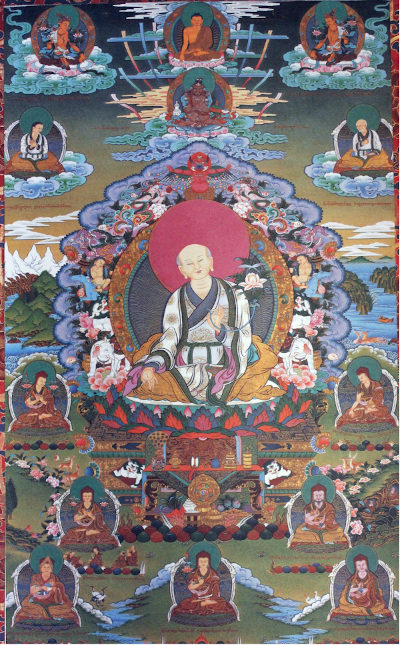
The Sakya tradition is one of the five major religious traditions that existed in Tibet. It rose as part of what is better known as the later phase of the spread of Buddhism in Tibet, which is largely associated with the translation of new Tantras in the 11th century.
During the 13th and 14th centuries, the holders of the Sakya tradition were also the principal spiritual and temporal powers that ruled over Tibet. The Sakya tradition strengthened, flourished and produced many great and distinguished scholars, practitioners and adepts. The word ‘Sa-kya’ is not to be confused with Shakya. It means ‘pale earth’ and the monastery and tradition is named after the landscape of Ponpori mountains. Sakya is closely connected with the ancestral lineage of the blessed ‘Khön’ family: a family which is believed to have originated from ‘celestial beings’. Prior to Khön Konchok Gyalpo (1034-1102), the founder of the Sakya monastery and tradition, the members of Khon were practitioners of Nyingmapa lineage.
Lamdre Teachings
The main teaching and practice that is the essence of the Sakya tradition is called “Lamdre (Lam/bras),” or “The Path and its Fruit.” Lamdre teaching predates the founding of Sakya lineage and the monastery. Prior to becoming the main teachings of the Sakyapas, those who practice Lamdre were known as Lamdre-pa. Fundamentally, the philosophical viewpoint expressed in “The Path and its Fruit,” is the “Non differentiation of Samsara and Nirvana.” According to this view, an individual cannot attain Nirvana or cyclic existence unless one understands the mind, which is the root of both Samsara and Nirvana. When the mind is obscured, it takes the form of Samsara and when the mind is freed of obstructions, it takes the form of Nirvana. The ultimate reality is that a person must strive to realize this fundamental inseparability through meditation. The Lamdre teachings are solidly based on the sutras as explained in Mahasiddha Virupa Vajra Verses’ Three Perceptions, (the deluded, yogic and enlightened perceptions) and Three Continuas, (the cause and path according to Hevajra tantric component of the path). This practice ultimately leads a practitioner to the state of the non duality of the clarity and emptiness as the deity in the form of Hevajra, which is unique to the Sakya tradition. If the seeker on the path recognises the deluded nature of Samsaric experiences, then he can access spiritual experiences to alter the deluded perceptions into yogic experiences and this can be greatly boosted to attain enlightened perceptions of high realisations. These realisations can tap into the ground luminosity of the mind which in turn becomes transmuted through the body method continua of seeing the subtle pure nature of the four intrinsic mandalas within through four empowerments to witness and non duality of clarity and emptiness of all things samara and nirvana without any discrimination whatsoever.
This profound teaching itself is attributed to Mahasiddha Virupa and his successors who include Krishnapa, Damarupa, Avadhuti and Gayadhara. They are all Indian adepts. Gayadhara came to Tibet and delivered the teachings to Drogmi Lotsawa Shakya Yeshe (992-1072), who travelled to India several times and also translated Hevajra Tantra and many texts into Tibetan. Drogmi Lotsawa guarded Lamdre teachings and taught under very strict circumstances to the faithful and melodious shepherd Seton Kunrig (1029-1116), who taught it to the manure digger, Shangton Choebar (1053-1135). During the time of these three Tibetans, it is simply known as Lamdrepas and it is the pre-Sakya period.
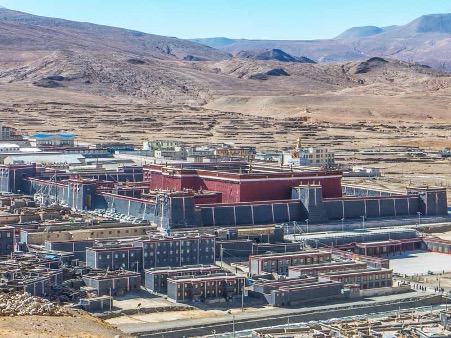
Sakya Monastery, Tibet
The original Sakya Monastery was founded in 1073 by Khon Khonchog Gyalpo. It is located on the bank of Trom-chu river in Sakya, in the Central Tibetan region of Tsang. From 1073 until 1959, this monastery served as the seat of the Sakya Order and its spiritual head, the Sakya Trizins. When the great Indian master Atisha, travelled to Tibet in 1042, he stopped and start doing prostrations towards the Ponpori hills. When asked why he did that, he replied, “I had visions of seed syllables HUM, HRIH and DHI on the slope of the hills”, and prophesied that in the near future a great many emanations of the Bodhisattvas would appear in this place and perform great activities for the benefit of the Dharma and all beings. The original monastery was situated as part of the northern bank of the river on the hill side. It includes many sacred statues and scriptures, including a stupa containing Khon Khonchog Gyalpo’s holy relics.
The Five Founders
Sachen Kunga Nyingpo, who was the son of Khon Konchok Gyalpo and the first of the five founders of the Sakya Order, was born at Sakya Monastery. He was the first of the Sakyapa to receive the precious Lam Dre teaching from Shangton Choebar and Mahasiddha Virupa and under his teaching and leadership, the Lam Dre was established as the core practice of the Sakyapa. He practised it eighteen years in complete secrecy and became the supreme owner of Lamdre teachings. He established the tradition of scholarship, wrote eleven commentaries on Virupa’s Vajra Verses and practice that was followed by succeeding founders and masters of the Sakya Order. Five of the foremost luminaries of the Sakya tradition are the renowned Sachen Künga Nyingpo (1092-1158), Lopön Sonam Tsemo (1142-1182), Jetsün Drakpa Gyaltsen (1147-1216), Sakya Pandita (1182-1251), and Drogön Chogyal Phagpa (1235-1280). Together, they are regarded as The Five Founding Masters of the Sakya Tradition.
Sakya’s Reign of Tibet
The political importance and dominance of Tibet by the Sakyapas started in the early 13th century. In 1240 the grandson of Genghis Khan by the name of Prince Godan ordered troops against the Tibetans. In the course of his campaign he was also looking for an outstanding Buddhist master. His commanders informed him that there were three famous lamas in Tibet . The Lama of Drikhung monastery was the wealthiest; the lama of Taklung monastery was the most sociable; and the lama of Sakya monastery was the most religious. Prince Godan then sent a letter and presents to the Sakya lama, Kunga Gyaltsen, requesting his presence in his court.
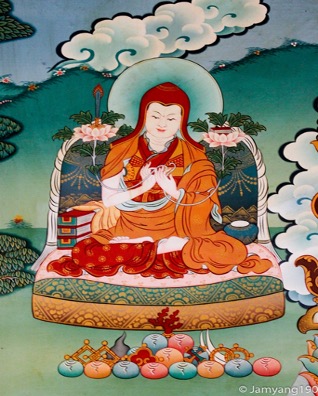
The invitation was accepted by Kunga Gyaltsen (1182-1251), who was also called Sakya Pandita, because of his knowledge of Sanskrit. He departed Sakya in the year 1244 for the Kokonor region where Prince Godan had his camp. Sakya Pandita took with him on the journey two of his nephews, the ten year-old Phagpa Lodro Gyaltsen and the six year-old Drogon Chakna. The Mongol representatives of Godan accompanied the party. Sakya Pandita gave many sermons along the way to the Kokonor region and because the journey was taking a long time, he sent his nephews on ahead. By the time he arrived in the camp of Godan in 1247, the two young Tibetans had won the hearts of the Mongols. According to Tibetan accounts, Sakya Pandita met Prince Godan at Lan-chow, the capital Kansu.
Sakya Pandita instructed Godan in the teachings of the Buddha and even persuaded him from drowning a large number of Chinese in the rivers. This was done in order to reduce the population since a large Chinese population was always a threat to the rule of Prince Godan, himself a Mongolian. The practice was stopped when Sakya Pandita convinced Godan that it was against the Buddhist doctrine to do so. Sakya Pandita remained in Godan’s court for several years during which he gave many religious instructions to the Prince and his followers. Saying he was too old to return to Tibet, Sakya Pandita sent a book he had written. It was titled “Thub-pai Gon-sal,” meaning “The Buddha’s Intent.” Knowing he did not have long to live, he left his book as a legacy to the country.
In 1251, Sakya Pandita passed away in Lan-chou, seventy years of age. Prince Godan died not long after Sakya Pandita and was succeeded by prince Kublai, who is also known as Sechen to the Tibetans. In 1253, Kublai invited the nineteen year-old Chogyal Phagpa to his court and was much impressed with the young monk’s learning, displayed in his intelligent answers to a number of difficult questions. Kublai then asked for religious instructions; but the young Sakya lama told him that before he could receive such teachings, Kublai would have to prostrate himself before Phagpa as his religious teacher whenever they met and to place him before or above, whenever they travelled or sat. Kublai replied that he could not do so in public, as it would involve a loss of prestige and therefore weaken his authority. Some sources say that Kublai consented to occupying a lower seat than his lama when receiving teachings and an equal seat when dealing with matters concerning the government.
According to tradition, Phagpa bestowed initiations and teachings to Kublai and twenty-five of his ministers on three occasions. The first earned him the spiritual and temporal authority over the thirteen principalities (Trikhor Chusum) of central Tibet. After the second, he was given a relic of the Buddha and invested with the supreme authority over the three regions of Tibet (chol-ska-sum). When Kublai became Khan in 1260, Phagpa was given the title of “Tishri,” meaning “Imperial Preceptor,” after the third initiation and teachings. In the same year, Phagpa was requested to conduct and preside over the enthronement ceremony of the new Khan. It is said that the lama-patron relationship between the Mongol Khan and the Tibetan lama was like “the sun and the moon in the sky.”
In 1265 Phagpa returned to Tibet for the first time. At Sakya he was given a rousing reception and honour by the Tibetan chieftains, who came to pay homage to him. Chogyal Phagpa introduced a centralized system of administration in Tibet. An official known as the “Ponchen,” who maintained his office in Sakya, carried out the actual administration. Under this official were the thirteen Tripons, who directly ruled in their own principality. The “Ponchen” appointed by Phagpa was named Ponchen Shakya Sangpo. In this way Chogyal Phagpa united Tibet under one Government and streamlined the administration.
At the invitation of Kublai Khan, in 1268 Chogyal Phagpa returned to the Khan’s court in Mongolia. He presented to the Khan a new script he had devised for the Mongolian language. Kublai was pleased and the new writing system, which would become known as “Phagpa Script” was put into official use. Phagpa was again honored by Khan, who bestowed on him the title of “Prince of Indian Deities,” “Miraculous Divine Lord Under the Sky and Above the Earth,” “Creator of the Script,” “Messenger of Peace throughout the World,” and “Possessor of the Five Higher Sciences.” In 1268 Chogyal Phagpa, founded Sakya Lhakhang Chen-mo monastery on the southern side of the river, and over the centuries it has grown into a complex of hundreds of temples, shrines, and monastic residences. The buildings contain thousands of statues, paintings, murals, stupas, mandalas, and other holy objects, as well as libraries of scriptures in Tibetan, Chinese, Mongolian, and Sanskrit piled from floor to ceiling. Among the holy objects in the monastery are the life size statue of Manjushri that spoke to Sakya Pandita to assist him during a famous debate; a small statue of Tara that was Atisha’s personal meditation object; and the conch shell blown by the Buddha’s disciples to summon monks to his teachings. Phagpa passed away in Sakya in 1280.
In the year of Phagpa’s death, Kublai Khan had finally conquered all of China, and had ascended the throne as the emperor of China. Dharmapala, Drogon Chakna’s son was appointed “Tishri” in 1282. In 1287, he set out for Tibet but died during the long journey. In the year 1295 the great Kublai Khan also died. Throughout the period of Sakya Pandita and later, the actual administration of Tibet remained with the Tibetans. The relationship between Mongol rulers and the Tibetan lamas cannot be defined in western political terms. An insight into the attitude of the Khan is shown by the lengths to which he went to please Chogyal Phagpa, whom he acknowledged and supported both as his spiritual teacher and as a supreme authority in Tibet . A unique patron-lama relationship was established between the Tibetans and the Mongols based upon mutual cooperation and respect.
After the death of Kublai Khan in 1295, the power of the Mongols began to decline to China. In 1305 Dagnyi Zangpo Pal came to the throne of Sakya and reigned for thirteen years. The political system carried out during Chogyal Phagpa’s period was continued with the actual powers held by Ponchen and the Tripons. During the administration of Ponchen Gawa Zangpo and the reign of ruling lama, Sonam Gyaltsen, the political strength of the Sakya began to wane in Tibet . Most of the later Sakya lamas concentrated more on their religious duties and left the entire political administration to the Ponchens.
The legacy of these Five masters, were immaculately carried out by a galaxy of Sakyapa scholars and adepts since there is hardly any Tibetan Buddhist traditions who have not been disciples of the great Sakyapa masters. There are specially well-known nine ornaments of Tibet who were also renowned spiritual masters of the Sakya tradition. The Nine Ornaments of Tibet comprised of Yakton Sengye Pal (1350-1414), Rongton Sheja Künrig (1367-1449), Rendawa Sonu Lodro (1349-1412) who were reputed for their authority on the teachings of the Sutra; Ngorchen Kunga Zangpo (1382-1450), Dzongpa Kunga Namgyal (1432-1496), and Tsarchen Losal Gyatso (1502-1566) who were highly learned in the Tantras; Gorampa Sonam Senge (1429-1489), Panchen Shakya Chogden (1428-2507) and Taktsang Lotsawa Sherab Rinchen (1405-1477) who were highly learned in both the Sutras and Tantras.
Sakya lineage has four sub-traditions: Sakya, Ngorpa, Dzongpa and Tsarpa. The main Sakya lineage itself appears to hold a unique practice of Vajrakilaya in addition to Thirteen Golden Dharmas of Sakya. The lineages of teachings within the discipline were instituted by Ngorchen Kunga Zangpo (1382-1457), who founded Ngor monastery and is known as the Ngor lineage, which is famous for its seven Anuttarayoga Mandala cycles. From the time of Ngorchen’s influential disciple, Muchen Sempa Chenpo, the Lamdre teachings was divided into two branches Tsogshe and Lobshe. The body of Lamdre literature has increased since the branching of the two traditions. The exceptional Lamdre Whispered lineage is attributed to Tsarchen Losel Gyatso (1502-1556), who founded Dhar Drangmo-che Monastery in Lhatse and is known as Tsarpa. It became the upholder of Lamdre Lobshe, the secret doctrines of the Mahakala, Vajrayogini and other esoteric teachings. Even the 5th Dalai Lama became a practitioner of Lamdre Lobshe and he has authored biographies of several Tsarpa lineage masters. Dzong-pa tradition is attributed to Dzongpa Kunga Namgyal (1432-1496) and is a branch with its own unique practices. To use a simple illustration, the Sakya School of the divine Khön lineage might represent the main trunk of a tree, from which the Ngorpa, Dzongpa and Tsarpa schools branch out in different directions, but essentially remain connected at the source as one.
Sakyapas in Exile
Following the political changes in Tibet during 1959, His Holiness Sakya Gongma Trichen Rinpoche and the other senior lamas of the Sakya Order relocated to northern India. A new monastery known as Sakya Centre was established in the town of Dehra Dun as the new headquarters of the order and the seat of the Sakya Trizin. Sakya college, Sakya nunnery, Sakya academy, Sakya Institute, Sakya College for Nuns and Sakya Settlement have been established all within the vicinity of Dehra Dun. Under the leadership of His Holiness Sakya Trizin, major portions of Sakya Monastery in Tibet that were destroyed during the Cultural Revolution have now been renovated, and religious activities there continue as they have for nearly a thousand years.
HH late Sakya Dagchen Jigdral Rinpoche from the Phuntsok Phodrang migrated to the USA and founded Sakya Monastery in Seattle. Although none of his sons have been formally trained to continue the lineage, three of grand-sons are being trained to take the reign of the Sakya Lineage in the near future.
His Holiness Sakya Gongma Trichen Rinpoche
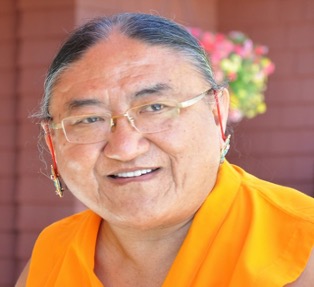
His Holiness Sakya Gongma Trichen Rinpoche served as the 41st Head of the Sakya Order of Tibetan Buddhism from 1958 until March 2017, when the throne holder duties were handed over to His son, His Holiness Ratna Vajra Rinpoche, the 42nd Sakya Trizin, formally addressed as His Holiness Kyabgon Gongma Trizin Rinpoche.
The Khön family from which the Sakya lineage has descended is known by three special names, each of which tell a story. Because the family is descended from Gods of the Realm of Clear Light who entered the human realm, the family came to be known as the “Celestial Race.” Then because this family subjugated the raksas, a class of harmful spirits, they were called “the Family of Conquerors.” Finally, because they also established the Sakya Order, they were known as “the Sakyapa Lineage.”
In more recent times, because the palace of the lineage to which the present Sakya Trizin belongs was built next to the turquoise Tara shrine at the Sakya Monastery in Tibet, this divine family also came to be known as the “Drolma Phodrang” or “Tara Palace” lineage. Since this celestial race descended upon earth over one thousand years ago, the lineage remains unbroken to this day. Many illustrious masters and practitioners have appeared in the lineage including the Five Great Masters of the Sakya Order. His Holiness, the present throne holder of the Sakya tradition, is the 42nd in an unbroken lineage that dates back to 1073 A.D.
His Holiness Sakya Trichen was born on the 7th of September 1945, the 1st day of the 8th Lunar month in the year of the Wood Bird at the Sakya palace in Tsedong. Immediately after his birth, in accordance with age-old traditions to increase his wisdom, the syllable DHIH was traced on his tongue and profound rituals were performed. Many signs traditionally associated with auspiciousness were observed on this day: the milk collected from a 100 different dri (female yaks) and a statue of the Guru Padmasambhava were miraculously offered to the Palace.
Initially given the Sanskrit name Ayu Vajra, His Holiness was only later given his actual name of Ngawang Kunga Thegchen Palbar Trinley Samphel Wangyi Gyalpo, when his father Vajradhara Ngawang Kunga Rinchen gave him his first major initiation, that of the Nine Deities of Amitayus. When His Holiness was only four years old, he received the major initiation of the peaceful and wrathful aspects of Vajrakilaya and many other profound teachings from his father.
His Holiness lost both his mother and father when he was very young. His maternal aunt then dedicated herself to raising His Holiness. She appointed his first tutor with whom His Holiness learned to read, write, memorize and recite basic prayers. He also learned chanting, music, ritual dancing, mudras, and so forth from his junior tutor. Both tutors taught His Holiness how to perform all the rituals and prayers in the traditions of both the northern and southern Sakya monasteries. At the conclusion of these studies, a great celebration was held, in which His Holiness officially entered the Mahayana and Vajrayana Monasteries to perform the traditional Sakya ceremonies. In 1950, at the age of five, his main root Guru, the great Ngor abbot Vajradhara Ngawang Lödron Shenphen Nyingpo bestowed upon him the Lamdre and other profound teachings.
In 1951, His Holiness made a pilgrimage to Lhasa, where he was designated to be the throne Holder of the Sakya Order by His Holiness the 14th Dalai Lama. Accordingly, the following year, a preliminary enthronement ceremony was held in which he accepted the official Sakya seals. Even at this early age, he was exceptionally intelligent and skilled in fulfilling his responsibilities. At the tender age of seven, he passed an extensive oral examination on the Hevajra root tantra at the Great Sakya monastery. At the Ngor monastery, the Great Ngor abbot and his root guru bestowed upon him both the common and uncommon Lamdre teachings. In 1953, in response to his root guru’s expressed intention to enter into Mahaparinirvana, His Holiness performed his first long life initiation of Amitayus at Ngor monastery and also undertook his first Hevajra meditation retreat in Sakya. His Holiness was then only eight years old.
The following year His Holiness received the initiation and reading transmission of the “Collection of Sadhanas” from Ngawang Tenzin Nyingpoi, the regent of Vajradhara Ngawang Lodro Shenphen Nyingpo. He also received the initiation and profound oral instructions of the Three Red Deities and the two main Protectors of the Sakya Order from Lama Ngawang Lodro Rinpoche. He also presided over an elaborate Vajrakilaya Ritual in the main Sakya monastery. At the age of ten, His Holiness again made a pilgrimage to Lhasa , where he received religious instructions in the Potala from His Holiness the Dalai Lama. Before a large audience, His Holiness gave an extensive explanation of the Mandala Offering, which caused his wisdom to be proclaimed throughout Tibet. On a pilgrimage to India he received many initiations and teachings belonging to the Sakya Tradition, as well as the Great Perfection and Dzogchen Teachings form Jamyang Khyentse Chokyi Lodro. In 1957, His Holiness received the Lamdre Teachings again, this time from the great abbot Vajradhara Khenchen Jampal Sangpo according to the Khon lineage transmission.
The preparatory ritual proceeding the official enthronement of His Holiness as the Sakya Trizin was performed in 1958. That year His Holiness also performed the Blessing Pill and Local Deity Rituals, as well as the extensive Vajrakilaya Ritual. In 1959, following a seven-day Mahakala ritual, His Holiness was formally enthroned as the throne Holder of Sakya in an elaborate three-day ceremony with the representatives of His Holiness the Dalai Lama and the Tibetan Government in attendance. On that occasion, he bestowed an explanation of the “Illumination of the Sage’s Intent” to the assembly of Sangha, guests and lay followers.
Following the Chinese invasion of Tibet in 1959, His Holiness escaped to India, established the Sakya Guru monastery in Darjeeling and began the major task of reassembling the Sakya community. In exile he continued to receive extensive philosophical teachings in Logic, Abhidharma, the Prajnaparamita and the Clarification of the Three Vows from great scholars such as Khenpo Dosep Thubten, Khenpo Serjong Appey and Tritso Khenpo Rinchen. From Khenpo Serjong Appey, he received a thorough and detailed explanation of the Hevajra Root Tantra and many other related teachings. From H.E. Phende Khen Rinpoche, who was also one of His Holiness’ root Gurus, he received the initiation and explanation of Yamantaka in the Ra Lotsawas tradition, as well as the collected writings of Ngorchen Konchok Lhundup.
In 1962, at the age of seventeen, His Holiness gave his first Hevajra initiation in Kalimpong. After moving to Mussoorie, in 1963 he established the main seat of the Sakya Order in Dehra Dun. The assembly of Sakya monks were relocated to the newly established Sakya Centre, where he gave many profound teachings and initiations. In the same year for the very first time, His Holiness gave the precious Lamdre teachings in Sarnath, Varanasi . A year later, he established the Sakya settlement, in Puruwala, Himachal Pradesh, for the lay members of the Sakya community.
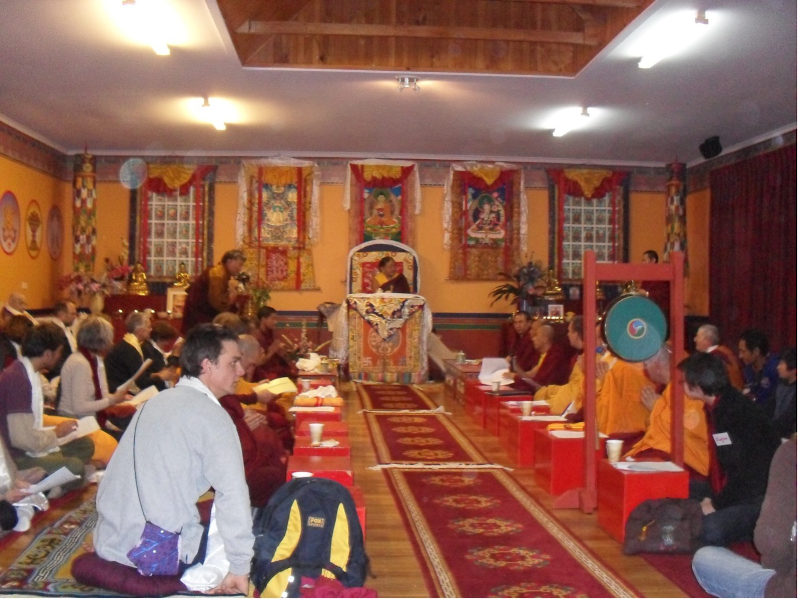
In 1971/2 HH Sakya Trichen received the Collection of Tantras empowerment, teachings, instruction and oral transmission from Kyabje Chogye Trichen Rinpoche over two summers. In order to maintain the tradition of the Khön family lineage, His Holiness married Tashi Lhakyi in 1974. Within the year they celebrated the auspicious birth of their elder son Ratna Vajra. In the meantime His Holiness made his first teaching tour of Europe, America and various countries in Asia. In 1976 His Holiness gave his second Lamdre teachings at the Sakya Centre. The following year, at the request of H.E. Luding Khen Rinpoche, His Holiness taught the “Collection of Sadhanas” in Ladakh. In 1977, he again gave teachings throughout Asia, Europe and the United States. Two years later, in 1979, his younger son Gyana Vajra was born.
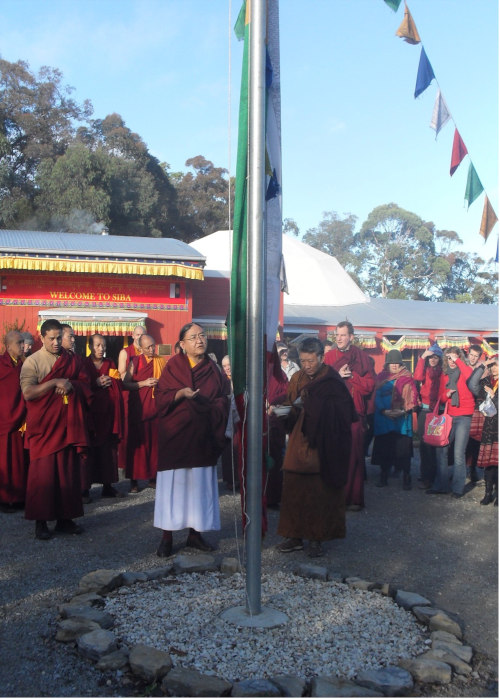
In 1980 His Holiness inaugurated the main Sakya monastery, Thubten Namgyal Ling in Puruwala, which he founded and bestowed Lamdre Lobshe teachings for the first time. This was the largest Sakyapa gathering, where even Dezhung Rinpoche travelled from Seattle, USA. In 1982, His Holiness the Dalai Lama paid an official visit to the monastery and bestowed many teachings. From Kyabje Chogye Trichen Rinpoche, His Holiness also received the uncommon Tsarpa tradition of Lamdre teachings and the Jo-nang tradition of “The Hundred Explanations.” A year later His Holiness performed a special long life ceremony for His Holiness the Dalai Lama in Dharamsala.
At Sakya Tsechen Ling in France he gave the Lamdre Lobshe teachings for the second time. In 1985, His Holiness consecrated the Jamchen Lhakhang, the Great Maitreya temple in Kathmandu at the request of Kyabje Chogye Trichen Rinpoche. At the end of that year he attended the Kalachakra initiation given by His Holiness the Dalai Lama in Bodh Gaya. In 1986, His Holiness once again gave the Lamdre teachings at the Sakya College to an assembly of monks led by Khenchen Kunga Wangchuk and western Dharma disciples. In 1988 His Holiness presided over the consecration of the newly built Ngorpa Centre in Manduwala. His Holiness remained there for several months in order to bestow over thirty major initiations of the Sakya tradition. The next year at the request of his many disciples in Europe, the United States and Canada, he travelled to each of the Sakya Dharma Centers there giving extensive teachings. Since then for the benefit of the Buddha Dharma and for his disciples, His Holiness has bestowed numerous initiations, teachings and public talks, traveling extensively worldwide to do so.
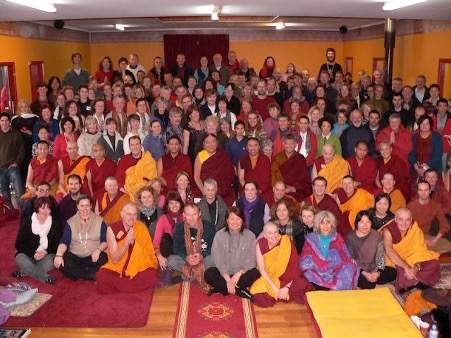
HH Sakya Gongma Trichen travelled to Australia and gave Lamdre teachings in 1988, 1997 and 2009. He gave both Lamdre Tsogshe and Lobshe at Vajradhara Gompa in Kyogle, both at the request of His Eminence Dzongsar Jamyang Khyentse Rinpoche. HH travelled to most cities in Australia and set thousands of people on the path to liberation. It is during His visit to Canberra in 1988, He gave blessings to the naming of ‘Sakya Losal Choe Dzong’, our centre which only then had three statues of Shakyamuni Buddha, Tara and Avalokiteshvara gifted by Lama Choedak to the group. HH conducted a special prayer of Lamdre Guru Puja at the Civic centre in Canberra in 1988. Over the years the seed of HH’s blessings sprouted well into many sister centres all over Australia.
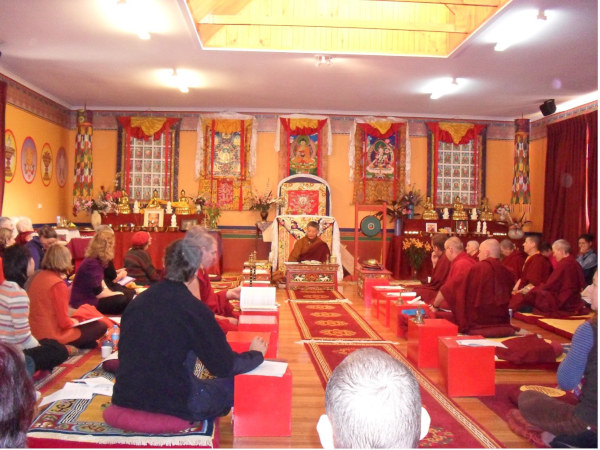
During His third visit to Australia, His Holiness gave Vajrayogini Blessings and teachings at Virupa Retreat Centre in 2002. On His fourth visit, He gave teachings Clarifying the Sages Intent at SIBA in 2009.
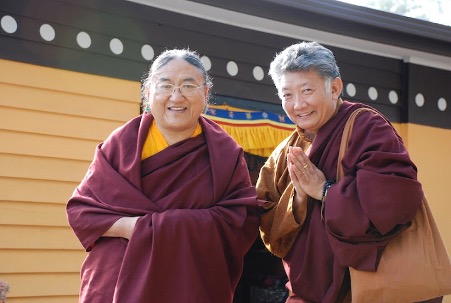
In 2017, HH Sakya Gongma Trichen handed over the reign of the Sakya lineage to His eldest son as the 42nd Sakya Trizin. HH continues to teach and guide all sentient beings.
His Holiness 42nd Sakya Trizin, Ratna Vajra Rinpoche
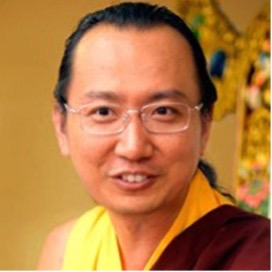
His Holiness the 42nd Kyabgon Gongma Trizin, Ratna Vajra Rinpoche, is the eldest son of His Holiness Sakya Trichen (the 41st Sakya Trizin). He is considered one of the most highly qualified lineage masters of Tibetan Buddhism. On March 9, 2017, His Holiness accepted the mantle of leadership from his esteemed father and root guru, in his new capacity as the 42nd Sakya Trizin or throne holder of the lineage. In doing so, he will continue to guide and inspire Dharma students from all over the world with his wisdom, genuine qualities of unaffected simplicity, humility and complete honesty, by presenting the Buddha’s teachings in the most authentic way, while maintaining the purest of Buddhist traditions.
Born on November 19, 1974, in Dehradun, India, His Holiness the 42nd Kyabgon Gongma Trizin was, from birth, the recipient of countless blessings, empowerments, and teachings from his father, His Holiness Kyabgon Sakya Gongma Trichen, as well as many other learned and accomplished masters.
Under the tutorship of Venerable Rinchen Sangpo, HH studied Tibetan reading, writing, grammar, memorization, and recitation of basic prayers and rituals. In 1987, when His Holiness was twelve, he passed his first major examination at the Sakya Centre in Rajpur, Dehradun. Two years later, he completed his basic studies of the major rituals and scriptures of the tradition. In 1990, His Holiness joined the Sakya College, where he studied mainly Buddhist philosophy under the late Khenpo Migmar Tsering. In 1998, after years of rigorous training, His Holiness completed his studies there and was awarded the Kachupa degree, “master of ten scriptures.” In addition to his philosophical studies, His Holiness received many exoteric and esoteric teachings, empowerments, blessings, initiations, oral transmissions, explanations and pith instructions, mainly from His Holiness Kyabgon Gongma Trichen, and also from many other important lineage masters, including His Holiness the 14th Dalai Lama, His Eminence Chogye Trichen Rinpoche, His Eminence Luding Khenchen Rinpoche, and Khenchen Appey Rinpoche. Starting from the early age of twelve, His Holiness has completed numerous meditation retreats, including the rigorous and complete Hevajra retreat, one of the prerequisites for bestowing the Lamdre empowerments.
In 2002, after a long search for a suitable wife, HH married Dagmo Kalden Dunkyi, who was chosen to be his spiritual consort. They have three children together, who are also being brought up in accordance with the ancient Buddhist traditions of scholarship. With wisdom and compassion, His Holiness continues to regularly transmit numerous empowerments and teachings at renowned Buddhist institutes such as the Sakya Institute, the Dzongsar Institute, Sakya College, Tantric College, International Buddhist Academy, and countless other schools, centres and monasteries all over the world.
HH 42nd Sakya Trizin Ratna Vajra Rinpoche has visited Australia several times and given numerous teachings at Sakya Losal Choe Dzong and at all of its sister centres. He gave the inaugural teachings on the Bodhisattva’s Way of Life for a whole month in 2008 at SIBA. In 2017, HH was enthroned as the 42nd Sakya Trizin at Puruwala, amidst what was seen as an epic religious ceremony with thousands of devotees flocking from all corners of the world. His latest visit to Australia was in 2019, when He gave Lamdre Jo-chakma, Hevajra Cause and Path empowerments at SIBA to a crowd of 108 people. He gave Vajrayogini Blessings at Virupa Retreat Centre and teachings in Sydney in 2019. In that same year HH also visited upper and lower Mustang and established many thousands of people on the path.
Read on to learn about the Tsarpa branch of the Sakya lineage, to which our centre belongs – click here >>
